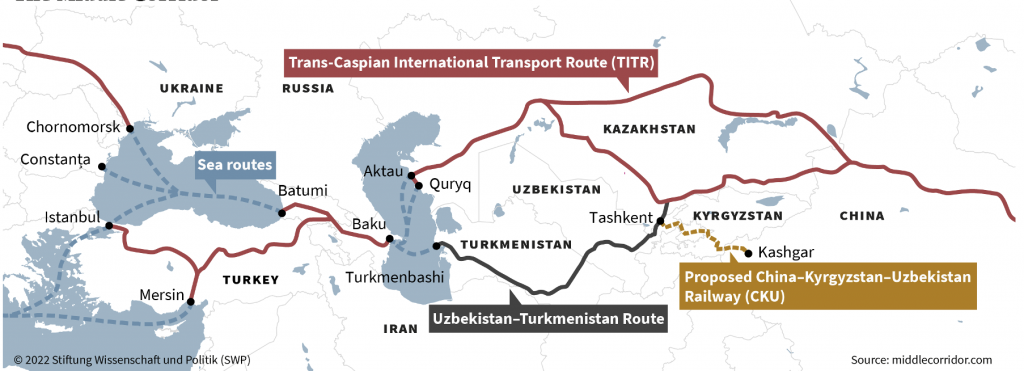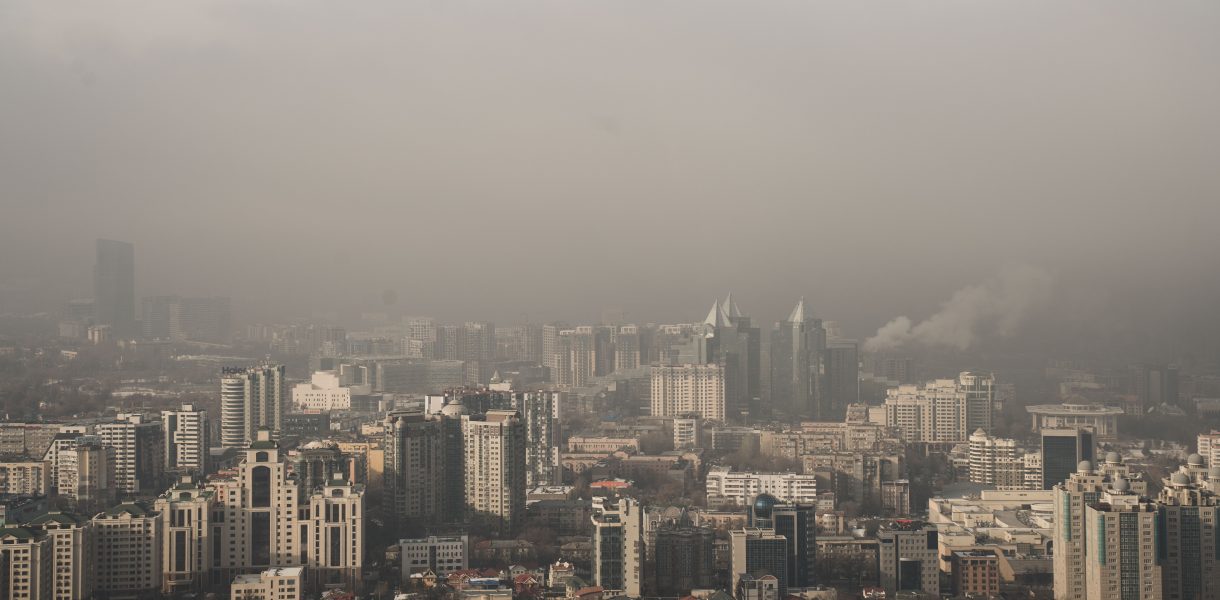The Middle Corridor investment project, in its current design, prioritizes profit over people in Central Asia and reflects principles that bear similarities to those seen in both Soviet and Western colonial practices in the region.
By Jeffrey Dunn, Crude Accountability Research Coordinator
What is The Middle Corridor?
The Middle Corridor is a Western-driven investment project, focused on natural resource extraction and infrastructure development. It consists of ports, pipelines, railways, and roadways designed to bypass Russia as a supply line for oil, natural gas, uranium, and other raw materials for the West, as well as to facilitate greater trade between China and the EU without hindrance from Moscow.
The Middle Corridor will connect Azerbaijan and Kazakhstan via the Caspian Sea, with potential involvement of other Central Asian states, such as Turkmenistan and Uzbekistan. Investments in Kazakhstan will link the corridor to China and investments in Azerbaijan will connect to Georgia and Turkey, which will link the corridor to the West via the Black Sea, the Mediterranean Sea, and the Bosphorus/Dardanelles straits.

The project is still in its infancy, but the pace is picking up with organizations such as the European Bank for Reconstruction and Development,[1] backed by EU and other western funding,[2] and the International Tax and Investment Center pushing investments in the corridor forward. US Secretary of State, Anthony Blinken, also noted $25 million in US investment in Central Asia to “diversify trade routes and create jobs in the region.”[3] Though the Middle Corridor is not specifically mentioned, the focus of the investment seems to parallel the Middle Corridor project.
Along with western corporate, government, and finance institutions, the governments of Kazakhstan and Azerbaijan have been hard at work promoting the project with investors. The presidents of both countries agreed to “leverage the full capacity” of the project in early April 2023,[4] and in May, an event encouraging investment in Kazakhstan and the Middle Corridor was held in Washington DC hosted by both American and Kazakh officials and attended by Crude Accountability.[5] Both governments eye economic potential in the project, but does this potential outweigh local environmental concerns?
Environmental Concerns and Local Voices in Kazakhstan
According to Alesya Nugayeva, founder of Eco-Kultura in Almaty, the answer is no. Nearly one out of three Almaty residents polled by her organization about their biggest concerns for their community cited the general state of the environment as their greatest concern.[6]
This is not surprising when we consider the historical and present status of environmental activism in the region. Established under the Aarhus Convention, which seeks to improve environmental governance and public access to environmental information, 31 Aarhus Centers in Central Asia, are dedicated to environment and security.[7] The region is home to numerous NGOs fighting to protect environmental and climate rights. It has also seen historical campaigns led by Kazakhstani environmental defenders, which centered around the Semipalatinsk nuclear polygon,[8] the relocation of the village of Berezovka away from the massive Karachaganak Oil and Gas Condensate Field,[9] and controversies around Chinese plans to move polluting industries from China and into Kazakhstan, including in the extractive industries.[10] Kazakhstani environmental groups have also worked hard to protect communities from the impacts of coal, protect air quality in major cities, and stop the development of national parks, among other environmental campaigns over the past 30 years.
Historical Precedents: Western Investments and Environmental Negligence
Western private investments initiated in the 1990s set an unfortunate precedent in Kazakhstan, ignoring environmental legislation and sidestepping international standards, making it clear why environmental concerns related to international investments remain important in Kazakhstan today. Companies like Chevron, ENI, ExxonMobil, and Shell invest significantly in three of Kazakhstan’s major oil and gas fields, Karachaganak, Kashagan, and Tengiz. All three fields are marked by controversy and environmental negligence.
Oil and gas condensate extraction at the Karachaganak Field polluted the surrounding region to such an extent that the village of Berezovka was forced to relocate after spikes in respiratory and cardiovascular disease, mass poisonings, mass faintings, food and water contamination, and the appearance of massive sinkholes in the vicinity of the community.[11]
Oil operations related to refining oil from the offshore Kashagan field violated local laws with excessive flaring, dumping toxic wastewater into the sewage system of the nearby city of Atyrau, and turning off its monitoring equipment. The company’s negligence decimated the Caspian seal population in the area,[12] increased threats to the endangered Beluga sturgeon,[13] and had the potential to contaminate local water supplies and damage the local sewage system.[14]
Finally, Tengiz, operated by Chevron, is a leader in environmental fines paid, and has the highest rate of industrial accidents within the oil and gas sector in the country. Tengiz was the site of several emergency situations related to the excessive release of emissions and pollutants and exposed villages around the field to dangerous sulfur and gas mixtures. Development of the field has left the region’s population at higher risk of circulatory system diseases and earthquakes.[15]
Soviet Colonialism: Environmental Exploitation
Environmental negligence is not a new challenge in this region. It also defined Soviet colonialism. Moscow exploited the natural resources of its satellite states with little regard for environmental impacts on local populations.
For example, the Aral Sea, once one of the largest lakes in the world, has been subject to severe desiccation due to the disastrous agricultural practices of the Soviet Union. Pollutants from pesticides, fertilizers, weapons testing, and industrial run-off combined with water diversion for cash crops, including cotton, led to an ever-drying lakebed, which now spreads toxic dust via the wind and contaminates the remaining groundwater. Toxins entered the food supply, resulting in a host of health problems that plague the region’s residents to this day.[16]
Other examples are Kazakhstan’s Semipalatinsk Test Site, the former central point for Soviet nuclear weapon testing,[17] and the Ferghana Valley–stretching between Kyrgyzstan, Uzbekistan, and Tajikistan–the site of numerous mining operations for uranium, zinc, and lead.[18] Both regions have been left with a legacy of radioactive and toxic material contaminating soil and water and polluting nearby communities.
The Middle Corridor: Ignoring Environmental Impacts and Climate Commitments
The people of the region have made it clear that economic growth should not come at the detriment of the environment and climate. Yet, the EBRD, EU, Azerbaijani and Kazakhstani governments, and other players in the public and private sectors have designed the Middle Corridor in ways similar to the colonial practices of decades past. So far, the project does not have in place plans to mitigate the environmental impacts it will have on a region already suffering from significant environmental scars.[19] Its proponents ignore the impact the project will have on the lives of local populations as well as their climate commitments. Resource exploitation, trade facilitation with China, and power politics over the region threaten the environment and well-being of Central Asian citizens and exacerbate climate impacts, continuing a long tradition of colonialism in the region.
[1] https://www.ebrd.com/work-with-us/projects/psd/53786.html
[2] https://www.ebrd.com/news/2022/ebrd-researches-sustainable-transport-connections-between-central-asia-and-europe-.html
[3] https://www.rferl.org/a/kazakhstan-us-blinken-meeting/32291409.html
[4] https://caspiannews.com/news-detail/azerbaijan-kazakhstan-agree-to-leverage-full-capacity-of-middle-corridor-2023-4-11-55/
[5] https://www.youtube.com/watch?v=nzA7it1Z_rA
[6] https://www.eurasia.org/success-stories/gamifying-eco-activism-in-kazakhstan/
[8] https://www.goldmanprize.org/recipient/kaisha-atakhanova/
[9] https://crudeaccountability.org/campaigns/karachaganak/the-campaign-2003-today/
[10] https://www.reuters.com/article/us-kazakhstan-china-protests/dozens-protest-against-chinese-influence-in-kazakhstan-idUSKCN1VP1B0
[11] https://crudeaccountability.org/wp-content/uploads/2013/06/20130604-Chevron20YrsInKazakhstan-en.pdf.pdf
See also
https://crudeaccountability.org/campaigns/karachaganak/
[12] https://crudeaccountability.org/wp-content/uploads/ENG_Kashagan_report_Final1-1.pdf
[13] https://friendsoftheearth.eu/press-release/banks-set-to-finance-disastrous-kashagan-oil-project/
[14] https://crudeaccountability.org/wp-content/uploads/ENG_Kashagan_report_Final1-1.pdf
[15] https://crudeaccountability.org/wp-content/uploads/2013/06/20130604-Chevron20YrsInKazakhstan-en.pdf.pdf
[16] https://intlpollution.commons.gc.cuny.edu/aral-sea-catastrophe/
[17] https://rus.azattyq.org/a/kazakhstan-semipalatinsk-nuclear-test-site-was-closed-30-years-ago/31431512.html
[18] https://www.reuters.com/article/us-kyrgyzstan-environment-nuclear-waste/mailbox-200-soviet-waste-dump-a-landslide-away-from-poisoning-millions-idUSKBN1XF10W
See also
[19] While the EBRD conducts environmental impact assessments, historically these assessments focus on the part of the project funded by the institution, with little or no regard for the overall impacts of the projects as a whole.

